Business Report: Exploring Types, Stakeholders, and Environments
VerifiedAdded on 2020/06/03
|9
|2751
|42
Report
AI Summary
This report provides a comprehensive analysis of the internal and external factors influencing business operations. It begins by defining different types of businesses—public, private, and voluntary—and explores their purposes and ownership structures. The report then identifies key stakeholders such as customers, employees, and suppliers, examining their influence on business decisions. It further delves into organizational structures, comparing hierarchical and flat structures, and their impact on fulfilling business objectives, using examples like ASDA and Apple. The report also examines how economic environments, including boom and recession, influence business activities, and analyzes the impact of political, legal, and social factors, such as minimum wage laws and consumer protection, on businesses like Coca-Cola. The report concludes by highlighting the interconnectedness of these factors and their collective impact on business success.
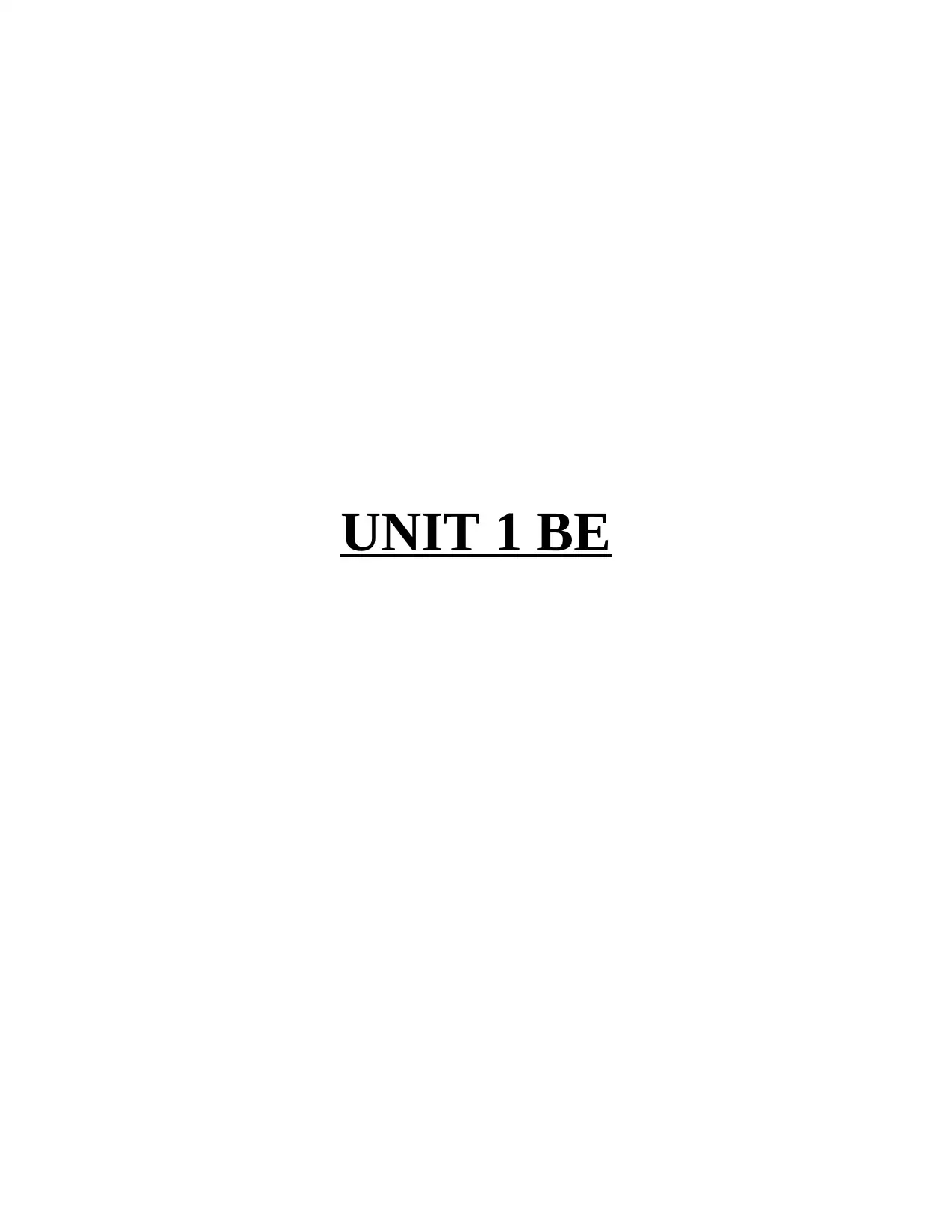
UNIT 1 BE
Paraphrase This Document
Need a fresh take? Get an instant paraphrase of this document with our AI Paraphraser
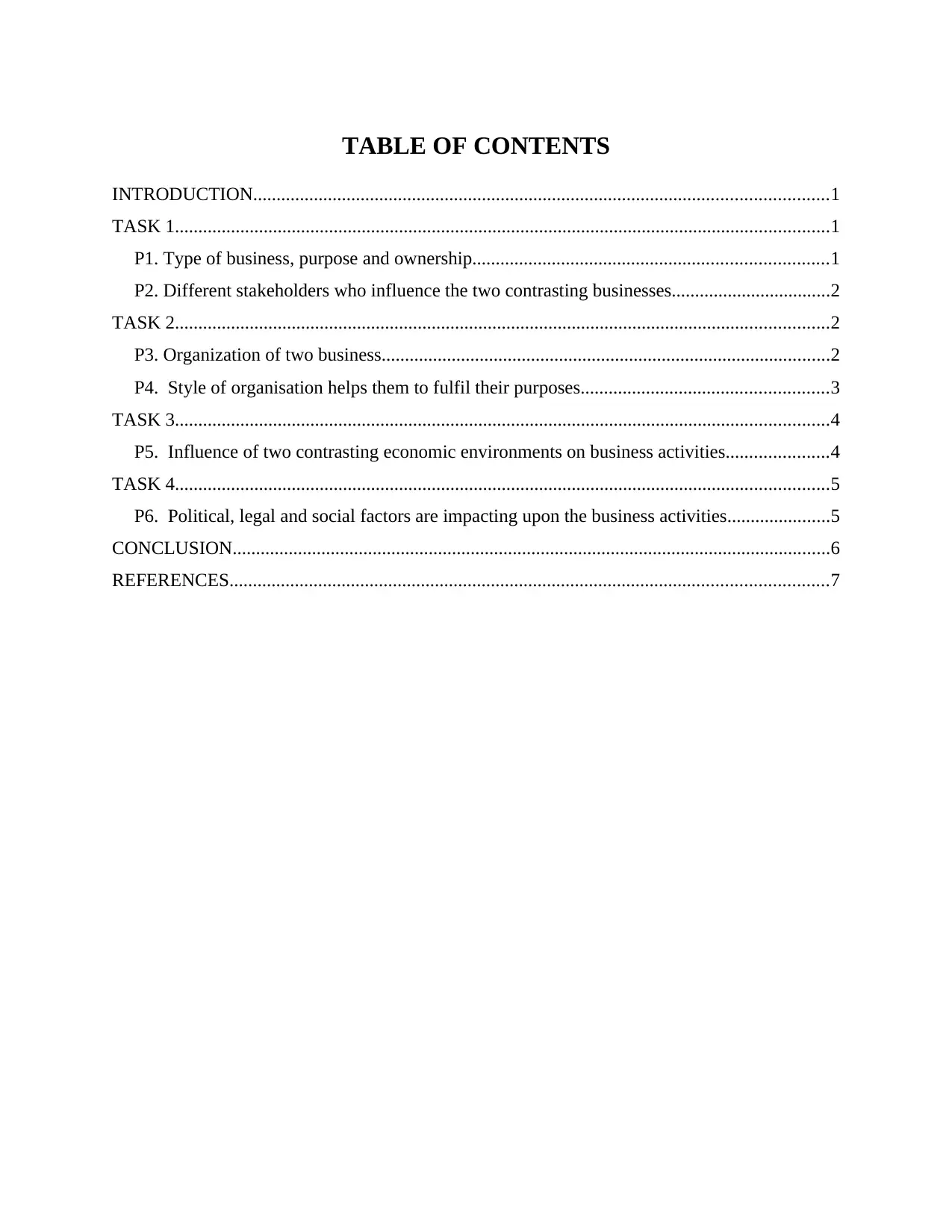
TABLE OF CONTENTS
INTRODUCTION...........................................................................................................................1
TASK 1............................................................................................................................................1
P1. Type of business, purpose and ownership............................................................................1
P2. Different stakeholders who influence the two contrasting businesses..................................2
TASK 2............................................................................................................................................2
P3. Organization of two business................................................................................................2
P4. Style of organisation helps them to fulfil their purposes.....................................................3
TASK 3............................................................................................................................................4
P5. Influence of two contrasting economic environments on business activities......................4
TASK 4............................................................................................................................................5
P6. Political, legal and social factors are impacting upon the business activities......................5
CONCLUSION................................................................................................................................6
REFERENCES................................................................................................................................7
INTRODUCTION...........................................................................................................................1
TASK 1............................................................................................................................................1
P1. Type of business, purpose and ownership............................................................................1
P2. Different stakeholders who influence the two contrasting businesses..................................2
TASK 2............................................................................................................................................2
P3. Organization of two business................................................................................................2
P4. Style of organisation helps them to fulfil their purposes.....................................................3
TASK 3............................................................................................................................................4
P5. Influence of two contrasting economic environments on business activities......................4
TASK 4............................................................................................................................................5
P6. Political, legal and social factors are impacting upon the business activities......................5
CONCLUSION................................................................................................................................6
REFERENCES................................................................................................................................7
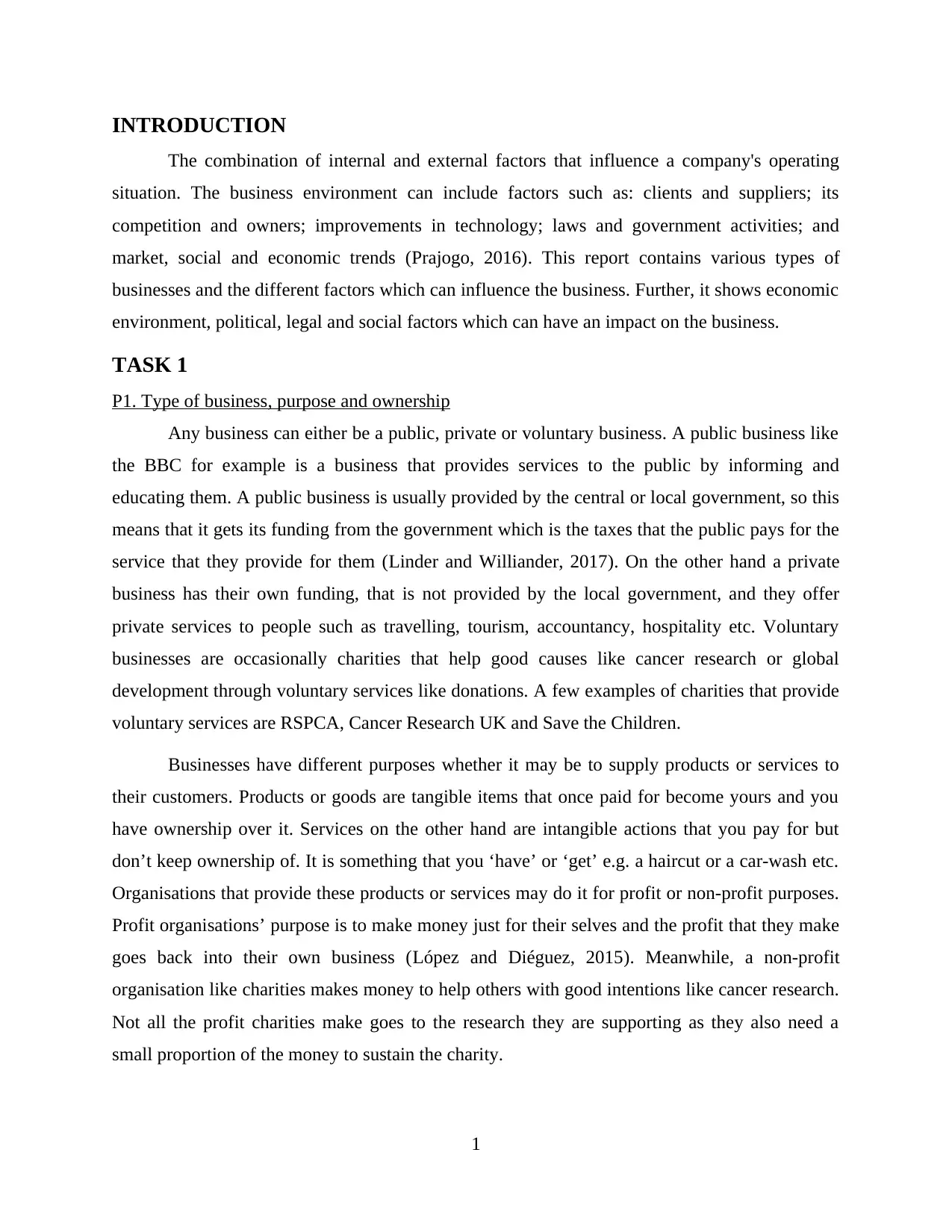
INTRODUCTION
The combination of internal and external factors that influence a company's operating
situation. The business environment can include factors such as: clients and suppliers; its
competition and owners; improvements in technology; laws and government activities; and
market, social and economic trends (Prajogo, 2016). This report contains various types of
businesses and the different factors which can influence the business. Further, it shows economic
environment, political, legal and social factors which can have an impact on the business.
TASK 1
P1. Type of business, purpose and ownership
Any business can either be a public, private or voluntary business. A public business like
the BBC for example is a business that provides services to the public by informing and
educating them. A public business is usually provided by the central or local government, so this
means that it gets its funding from the government which is the taxes that the public pays for the
service that they provide for them (Linder and Williander, 2017). On the other hand a private
business has their own funding, that is not provided by the local government, and they offer
private services to people such as travelling, tourism, accountancy, hospitality etc. Voluntary
businesses are occasionally charities that help good causes like cancer research or global
development through voluntary services like donations. A few examples of charities that provide
voluntary services are RSPCA, Cancer Research UK and Save the Children.
Businesses have different purposes whether it may be to supply products or services to
their customers. Products or goods are tangible items that once paid for become yours and you
have ownership over it. Services on the other hand are intangible actions that you pay for but
don’t keep ownership of. It is something that you ‘have’ or ‘get’ e.g. a haircut or a car-wash etc.
Organisations that provide these products or services may do it for profit or non-profit purposes.
Profit organisations’ purpose is to make money just for their selves and the profit that they make
goes back into their own business (López and Diéguez, 2015). Meanwhile, a non-profit
organisation like charities makes money to help others with good intentions like cancer research.
Not all the profit charities make goes to the research they are supporting as they also need a
small proportion of the money to sustain the charity.
1
The combination of internal and external factors that influence a company's operating
situation. The business environment can include factors such as: clients and suppliers; its
competition and owners; improvements in technology; laws and government activities; and
market, social and economic trends (Prajogo, 2016). This report contains various types of
businesses and the different factors which can influence the business. Further, it shows economic
environment, political, legal and social factors which can have an impact on the business.
TASK 1
P1. Type of business, purpose and ownership
Any business can either be a public, private or voluntary business. A public business like
the BBC for example is a business that provides services to the public by informing and
educating them. A public business is usually provided by the central or local government, so this
means that it gets its funding from the government which is the taxes that the public pays for the
service that they provide for them (Linder and Williander, 2017). On the other hand a private
business has their own funding, that is not provided by the local government, and they offer
private services to people such as travelling, tourism, accountancy, hospitality etc. Voluntary
businesses are occasionally charities that help good causes like cancer research or global
development through voluntary services like donations. A few examples of charities that provide
voluntary services are RSPCA, Cancer Research UK and Save the Children.
Businesses have different purposes whether it may be to supply products or services to
their customers. Products or goods are tangible items that once paid for become yours and you
have ownership over it. Services on the other hand are intangible actions that you pay for but
don’t keep ownership of. It is something that you ‘have’ or ‘get’ e.g. a haircut or a car-wash etc.
Organisations that provide these products or services may do it for profit or non-profit purposes.
Profit organisations’ purpose is to make money just for their selves and the profit that they make
goes back into their own business (López and Diéguez, 2015). Meanwhile, a non-profit
organisation like charities makes money to help others with good intentions like cancer research.
Not all the profit charities make goes to the research they are supporting as they also need a
small proportion of the money to sustain the charity.
1
⊘ This is a preview!⊘
Do you want full access?
Subscribe today to unlock all pages.

Trusted by 1+ million students worldwide
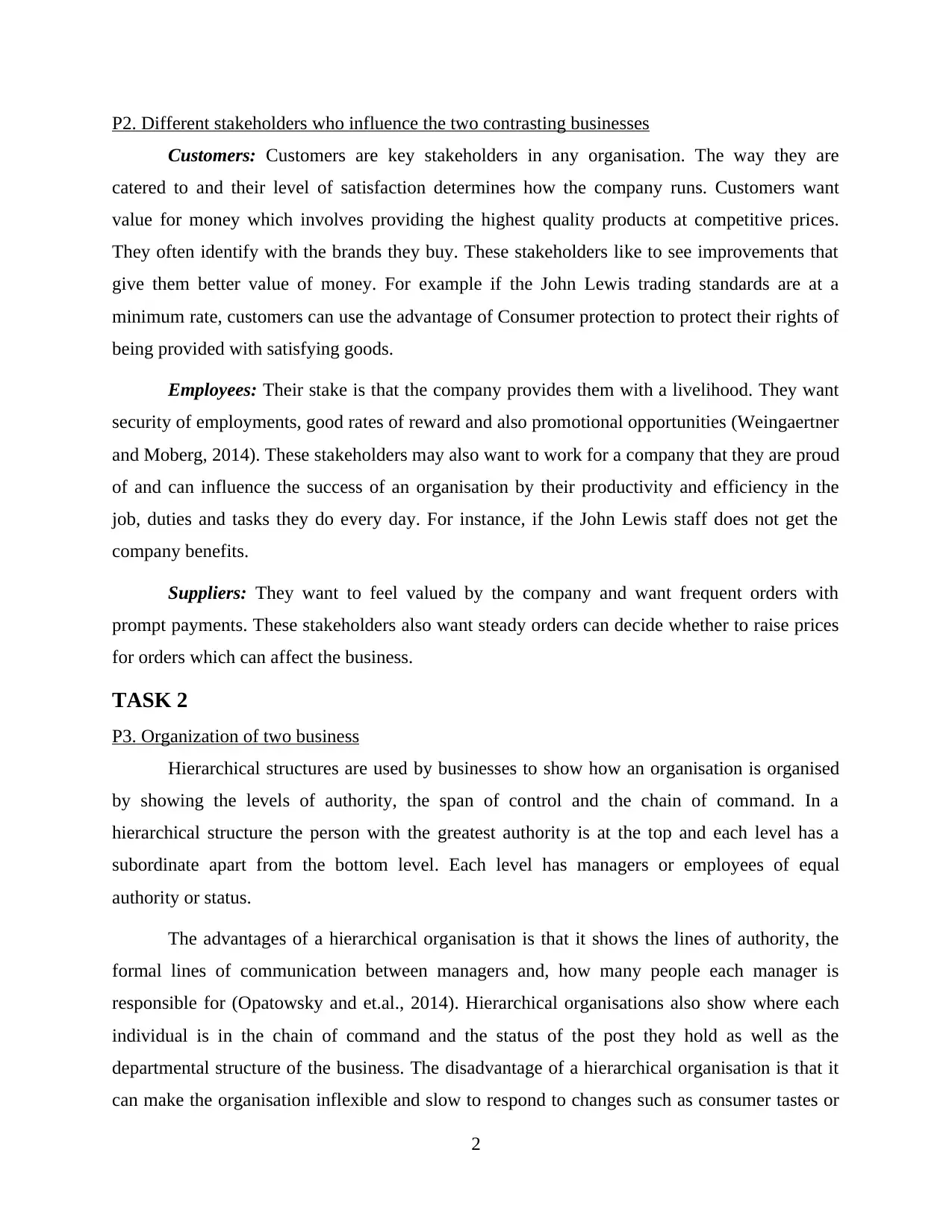
P2. Different stakeholders who influence the two contrasting businesses
Customers: Customers are key stakeholders in any organisation. The way they are
catered to and their level of satisfaction determines how the company runs. Customers want
value for money which involves providing the highest quality products at competitive prices.
They often identify with the brands they buy. These stakeholders like to see improvements that
give them better value of money. For example if the John Lewis trading standards are at a
minimum rate, customers can use the advantage of Consumer protection to protect their rights of
being provided with satisfying goods.
Employees: Their stake is that the company provides them with a livelihood. They want
security of employments, good rates of reward and also promotional opportunities (Weingaertner
and Moberg, 2014). These stakeholders may also want to work for a company that they are proud
of and can influence the success of an organisation by their productivity and efficiency in the
job, duties and tasks they do every day. For instance, if the John Lewis staff does not get the
company benefits.
Suppliers: They want to feel valued by the company and want frequent orders with
prompt payments. These stakeholders also want steady orders can decide whether to raise prices
for orders which can affect the business.
TASK 2
P3. Organization of two business
Hierarchical structures are used by businesses to show how an organisation is organised
by showing the levels of authority, the span of control and the chain of command. In a
hierarchical structure the person with the greatest authority is at the top and each level has a
subordinate apart from the bottom level. Each level has managers or employees of equal
authority or status.
The advantages of a hierarchical organisation is that it shows the lines of authority, the
formal lines of communication between managers and, how many people each manager is
responsible for (Opatowsky and et.al., 2014). Hierarchical organisations also show where each
individual is in the chain of command and the status of the post they hold as well as the
departmental structure of the business. The disadvantage of a hierarchical organisation is that it
can make the organisation inflexible and slow to respond to changes such as consumer tastes or
2
Customers: Customers are key stakeholders in any organisation. The way they are
catered to and their level of satisfaction determines how the company runs. Customers want
value for money which involves providing the highest quality products at competitive prices.
They often identify with the brands they buy. These stakeholders like to see improvements that
give them better value of money. For example if the John Lewis trading standards are at a
minimum rate, customers can use the advantage of Consumer protection to protect their rights of
being provided with satisfying goods.
Employees: Their stake is that the company provides them with a livelihood. They want
security of employments, good rates of reward and also promotional opportunities (Weingaertner
and Moberg, 2014). These stakeholders may also want to work for a company that they are proud
of and can influence the success of an organisation by their productivity and efficiency in the
job, duties and tasks they do every day. For instance, if the John Lewis staff does not get the
company benefits.
Suppliers: They want to feel valued by the company and want frequent orders with
prompt payments. These stakeholders also want steady orders can decide whether to raise prices
for orders which can affect the business.
TASK 2
P3. Organization of two business
Hierarchical structures are used by businesses to show how an organisation is organised
by showing the levels of authority, the span of control and the chain of command. In a
hierarchical structure the person with the greatest authority is at the top and each level has a
subordinate apart from the bottom level. Each level has managers or employees of equal
authority or status.
The advantages of a hierarchical organisation is that it shows the lines of authority, the
formal lines of communication between managers and, how many people each manager is
responsible for (Opatowsky and et.al., 2014). Hierarchical organisations also show where each
individual is in the chain of command and the status of the post they hold as well as the
departmental structure of the business. The disadvantage of a hierarchical organisation is that it
can make the organisation inflexible and slow to respond to changes such as consumer tastes or
2
Paraphrase This Document
Need a fresh take? Get an instant paraphrase of this document with our AI Paraphraser
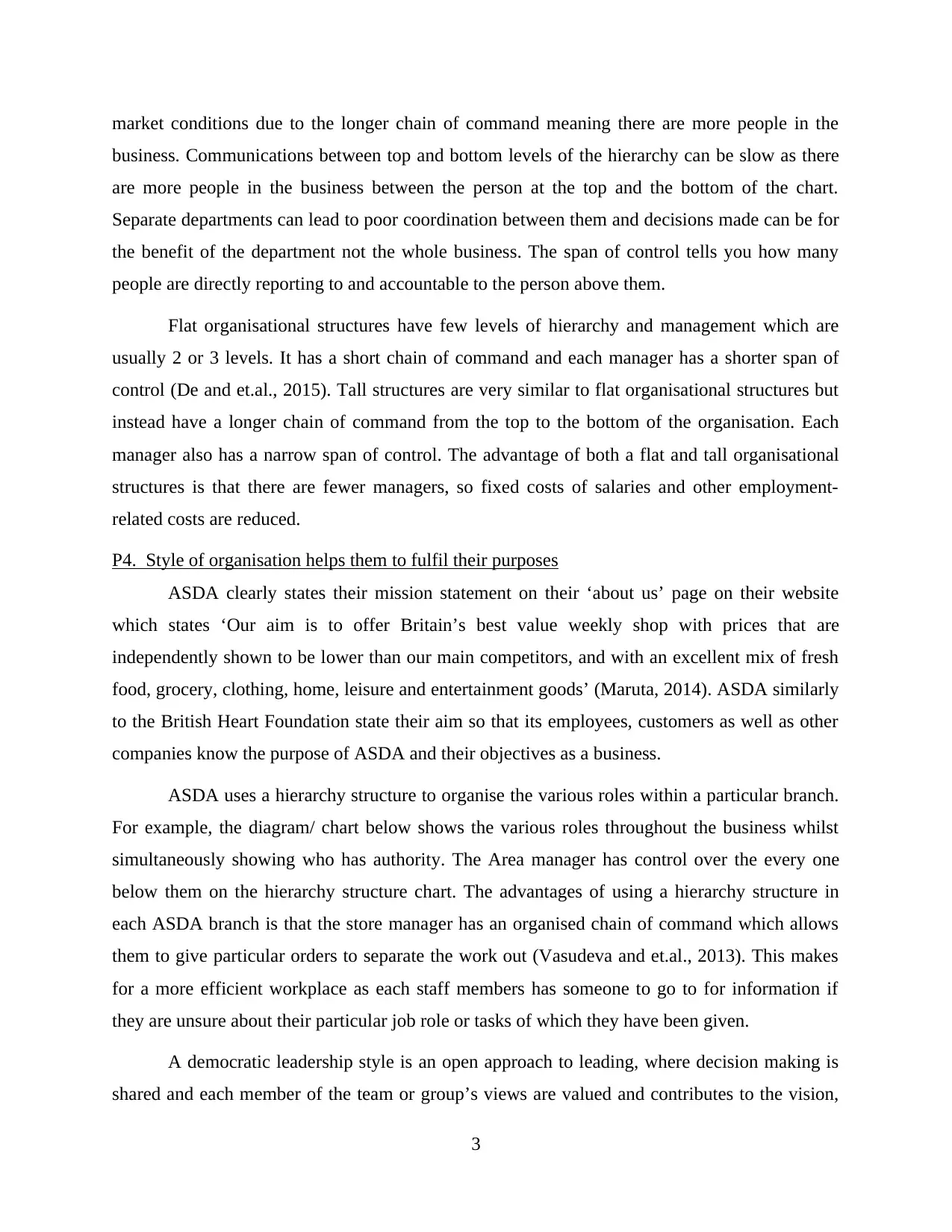
market conditions due to the longer chain of command meaning there are more people in the
business. Communications between top and bottom levels of the hierarchy can be slow as there
are more people in the business between the person at the top and the bottom of the chart.
Separate departments can lead to poor coordination between them and decisions made can be for
the benefit of the department not the whole business. The span of control tells you how many
people are directly reporting to and accountable to the person above them.
Flat organisational structures have few levels of hierarchy and management which are
usually 2 or 3 levels. It has a short chain of command and each manager has a shorter span of
control (De and et.al., 2015). Tall structures are very similar to flat organisational structures but
instead have a longer chain of command from the top to the bottom of the organisation. Each
manager also has a narrow span of control. The advantage of both a flat and tall organisational
structures is that there are fewer managers, so fixed costs of salaries and other employment-
related costs are reduced.
P4. Style of organisation helps them to fulfil their purposes
ASDA clearly states their mission statement on their ‘about us’ page on their website
which states ‘Our aim is to offer Britain’s best value weekly shop with prices that are
independently shown to be lower than our main competitors, and with an excellent mix of fresh
food, grocery, clothing, home, leisure and entertainment goods’ (Maruta, 2014). ASDA similarly
to the British Heart Foundation state their aim so that its employees, customers as well as other
companies know the purpose of ASDA and their objectives as a business.
ASDA uses a hierarchy structure to organise the various roles within a particular branch.
For example, the diagram/ chart below shows the various roles throughout the business whilst
simultaneously showing who has authority. The Area manager has control over the every one
below them on the hierarchy structure chart. The advantages of using a hierarchy structure in
each ASDA branch is that the store manager has an organised chain of command which allows
them to give particular orders to separate the work out (Vasudeva and et.al., 2013). This makes
for a more efficient workplace as each staff members has someone to go to for information if
they are unsure about their particular job role or tasks of which they have been given.
A democratic leadership style is an open approach to leading, where decision making is
shared and each member of the team or group’s views are valued and contributes to the vision,
3
business. Communications between top and bottom levels of the hierarchy can be slow as there
are more people in the business between the person at the top and the bottom of the chart.
Separate departments can lead to poor coordination between them and decisions made can be for
the benefit of the department not the whole business. The span of control tells you how many
people are directly reporting to and accountable to the person above them.
Flat organisational structures have few levels of hierarchy and management which are
usually 2 or 3 levels. It has a short chain of command and each manager has a shorter span of
control (De and et.al., 2015). Tall structures are very similar to flat organisational structures but
instead have a longer chain of command from the top to the bottom of the organisation. Each
manager also has a narrow span of control. The advantage of both a flat and tall organisational
structures is that there are fewer managers, so fixed costs of salaries and other employment-
related costs are reduced.
P4. Style of organisation helps them to fulfil their purposes
ASDA clearly states their mission statement on their ‘about us’ page on their website
which states ‘Our aim is to offer Britain’s best value weekly shop with prices that are
independently shown to be lower than our main competitors, and with an excellent mix of fresh
food, grocery, clothing, home, leisure and entertainment goods’ (Maruta, 2014). ASDA similarly
to the British Heart Foundation state their aim so that its employees, customers as well as other
companies know the purpose of ASDA and their objectives as a business.
ASDA uses a hierarchy structure to organise the various roles within a particular branch.
For example, the diagram/ chart below shows the various roles throughout the business whilst
simultaneously showing who has authority. The Area manager has control over the every one
below them on the hierarchy structure chart. The advantages of using a hierarchy structure in
each ASDA branch is that the store manager has an organised chain of command which allows
them to give particular orders to separate the work out (Vasudeva and et.al., 2013). This makes
for a more efficient workplace as each staff members has someone to go to for information if
they are unsure about their particular job role or tasks of which they have been given.
A democratic leadership style is an open approach to leading, where decision making is
shared and each member of the team or group’s views are valued and contributes to the vision,
3
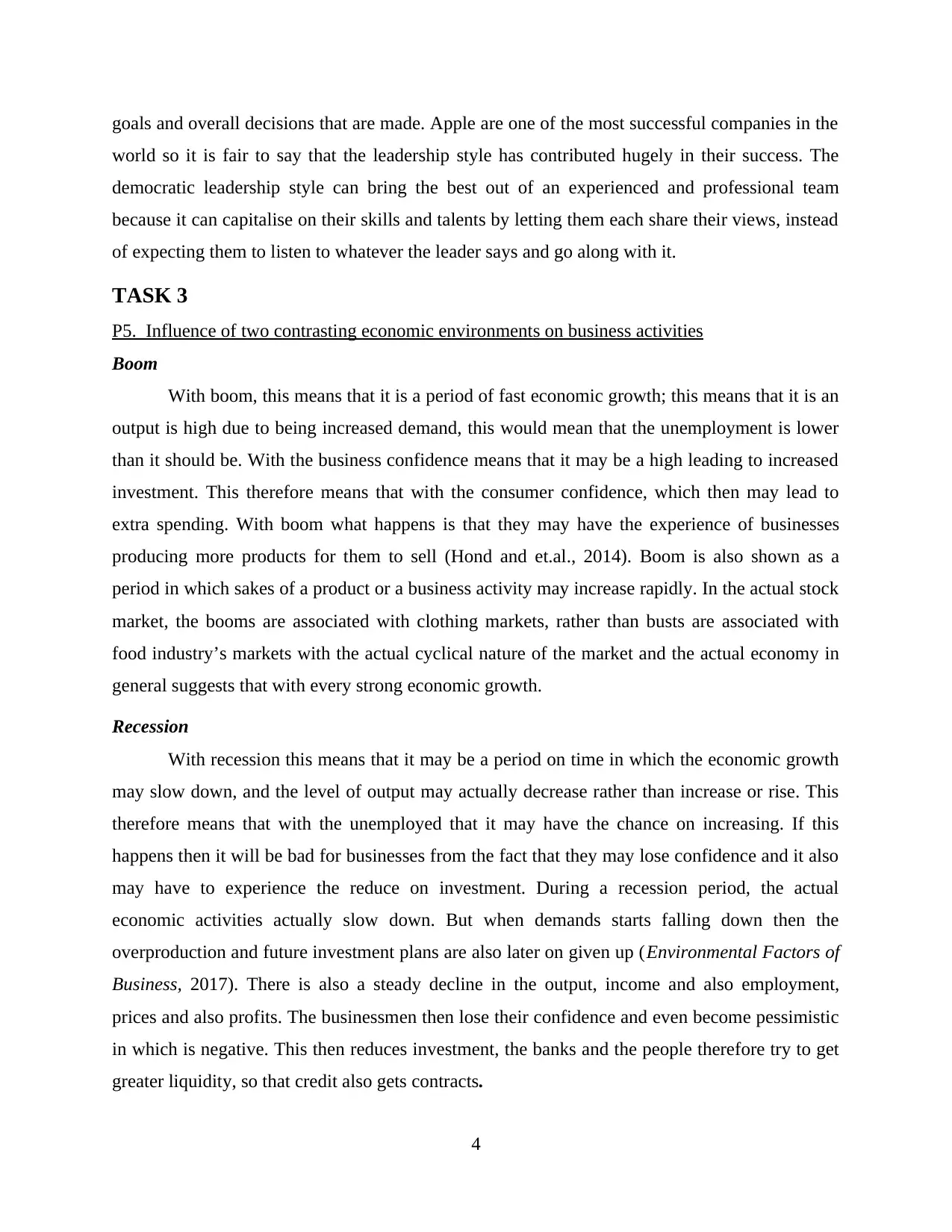
goals and overall decisions that are made. Apple are one of the most successful companies in the
world so it is fair to say that the leadership style has contributed hugely in their success. The
democratic leadership style can bring the best out of an experienced and professional team
because it can capitalise on their skills and talents by letting them each share their views, instead
of expecting them to listen to whatever the leader says and go along with it.
TASK 3
P5. Influence of two contrasting economic environments on business activities
Boom
With boom, this means that it is a period of fast economic growth; this means that it is an
output is high due to being increased demand, this would mean that the unemployment is lower
than it should be. With the business confidence means that it may be a high leading to increased
investment. This therefore means that with the consumer confidence, which then may lead to
extra spending. With boom what happens is that they may have the experience of businesses
producing more products for them to sell (Hond and et.al., 2014). Boom is also shown as a
period in which sakes of a product or a business activity may increase rapidly. In the actual stock
market, the booms are associated with clothing markets, rather than busts are associated with
food industry’s markets with the actual cyclical nature of the market and the actual economy in
general suggests that with every strong economic growth.
Recession
With recession this means that it may be a period on time in which the economic growth
may slow down, and the level of output may actually decrease rather than increase or rise. This
therefore means that with the unemployed that it may have the chance on increasing. If this
happens then it will be bad for businesses from the fact that they may lose confidence and it also
may have to experience the reduce on investment. During a recession period, the actual
economic activities actually slow down. But when demands starts falling down then the
overproduction and future investment plans are also later on given up (Environmental Factors of
Business, 2017). There is also a steady decline in the output, income and also employment,
prices and also profits. The businessmen then lose their confidence and even become pessimistic
in which is negative. This then reduces investment, the banks and the people therefore try to get
greater liquidity, so that credit also gets contracts.
4
world so it is fair to say that the leadership style has contributed hugely in their success. The
democratic leadership style can bring the best out of an experienced and professional team
because it can capitalise on their skills and talents by letting them each share their views, instead
of expecting them to listen to whatever the leader says and go along with it.
TASK 3
P5. Influence of two contrasting economic environments on business activities
Boom
With boom, this means that it is a period of fast economic growth; this means that it is an
output is high due to being increased demand, this would mean that the unemployment is lower
than it should be. With the business confidence means that it may be a high leading to increased
investment. This therefore means that with the consumer confidence, which then may lead to
extra spending. With boom what happens is that they may have the experience of businesses
producing more products for them to sell (Hond and et.al., 2014). Boom is also shown as a
period in which sakes of a product or a business activity may increase rapidly. In the actual stock
market, the booms are associated with clothing markets, rather than busts are associated with
food industry’s markets with the actual cyclical nature of the market and the actual economy in
general suggests that with every strong economic growth.
Recession
With recession this means that it may be a period on time in which the economic growth
may slow down, and the level of output may actually decrease rather than increase or rise. This
therefore means that with the unemployed that it may have the chance on increasing. If this
happens then it will be bad for businesses from the fact that they may lose confidence and it also
may have to experience the reduce on investment. During a recession period, the actual
economic activities actually slow down. But when demands starts falling down then the
overproduction and future investment plans are also later on given up (Environmental Factors of
Business, 2017). There is also a steady decline in the output, income and also employment,
prices and also profits. The businessmen then lose their confidence and even become pessimistic
in which is negative. This then reduces investment, the banks and the people therefore try to get
greater liquidity, so that credit also gets contracts.
4
⊘ This is a preview!⊘
Do you want full access?
Subscribe today to unlock all pages.

Trusted by 1+ million students worldwide
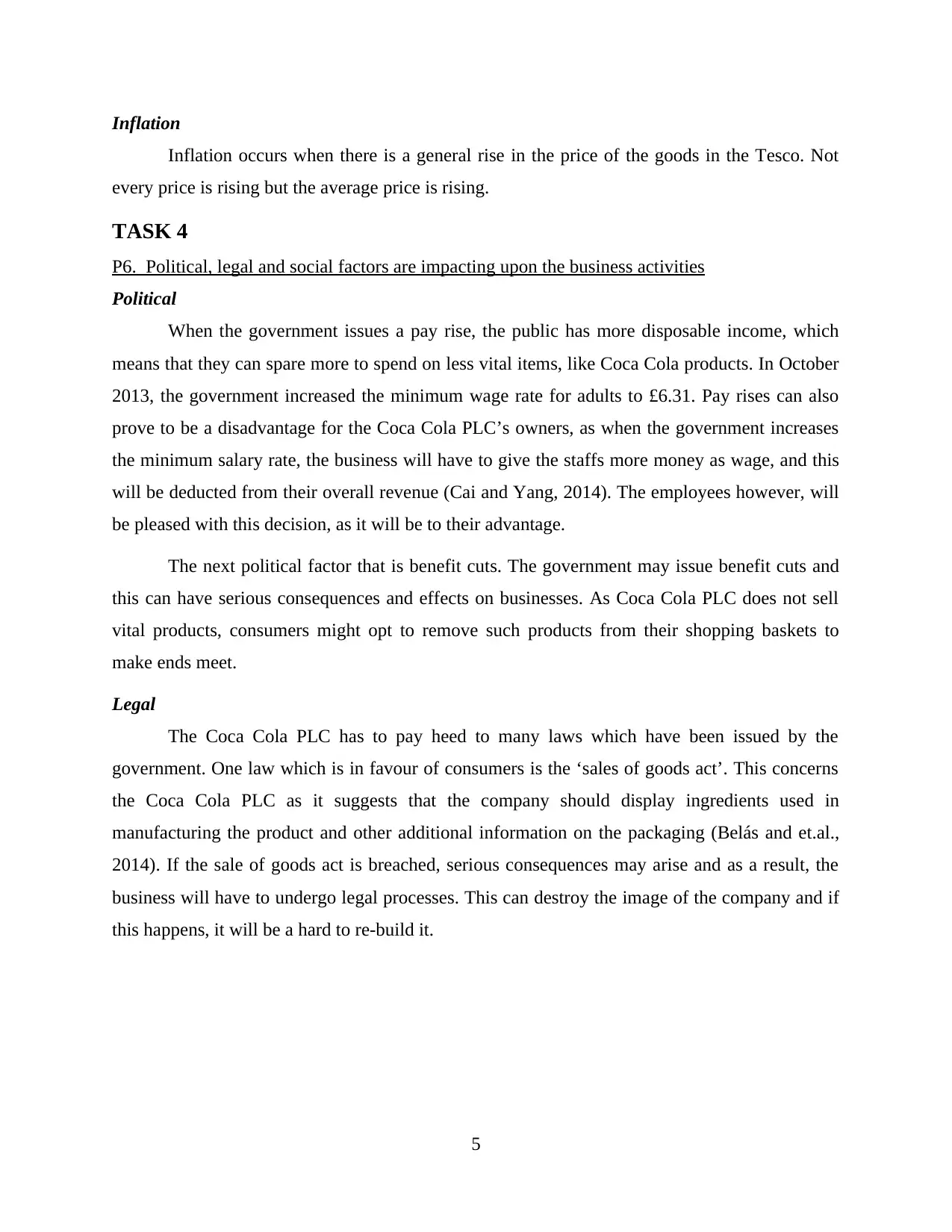
Inflation
Inflation occurs when there is a general rise in the price of the goods in the Tesco. Not
every price is rising but the average price is rising.
TASK 4
P6. Political, legal and social factors are impacting upon the business activities
Political
When the government issues a pay rise, the public has more disposable income, which
means that they can spare more to spend on less vital items, like Coca Cola products. In October
2013, the government increased the minimum wage rate for adults to £6.31. Pay rises can also
prove to be a disadvantage for the Coca Cola PLC’s owners, as when the government increases
the minimum salary rate, the business will have to give the staffs more money as wage, and this
will be deducted from their overall revenue (Cai and Yang, 2014). The employees however, will
be pleased with this decision, as it will be to their advantage.
The next political factor that is benefit cuts. The government may issue benefit cuts and
this can have serious consequences and effects on businesses. As Coca Cola PLC does not sell
vital products, consumers might opt to remove such products from their shopping baskets to
make ends meet.
Legal
The Coca Cola PLC has to pay heed to many laws which have been issued by the
government. One law which is in favour of consumers is the ‘sales of goods act’. This concerns
the Coca Cola PLC as it suggests that the company should display ingredients used in
manufacturing the product and other additional information on the packaging (Belás and et.al.,
2014). If the sale of goods act is breached, serious consequences may arise and as a result, the
business will have to undergo legal processes. This can destroy the image of the company and if
this happens, it will be a hard to re-build it.
5
Inflation occurs when there is a general rise in the price of the goods in the Tesco. Not
every price is rising but the average price is rising.
TASK 4
P6. Political, legal and social factors are impacting upon the business activities
Political
When the government issues a pay rise, the public has more disposable income, which
means that they can spare more to spend on less vital items, like Coca Cola products. In October
2013, the government increased the minimum wage rate for adults to £6.31. Pay rises can also
prove to be a disadvantage for the Coca Cola PLC’s owners, as when the government increases
the minimum salary rate, the business will have to give the staffs more money as wage, and this
will be deducted from their overall revenue (Cai and Yang, 2014). The employees however, will
be pleased with this decision, as it will be to their advantage.
The next political factor that is benefit cuts. The government may issue benefit cuts and
this can have serious consequences and effects on businesses. As Coca Cola PLC does not sell
vital products, consumers might opt to remove such products from their shopping baskets to
make ends meet.
Legal
The Coca Cola PLC has to pay heed to many laws which have been issued by the
government. One law which is in favour of consumers is the ‘sales of goods act’. This concerns
the Coca Cola PLC as it suggests that the company should display ingredients used in
manufacturing the product and other additional information on the packaging (Belás and et.al.,
2014). If the sale of goods act is breached, serious consequences may arise and as a result, the
business will have to undergo legal processes. This can destroy the image of the company and if
this happens, it will be a hard to re-build it.
5
Paraphrase This Document
Need a fresh take? Get an instant paraphrase of this document with our AI Paraphraser
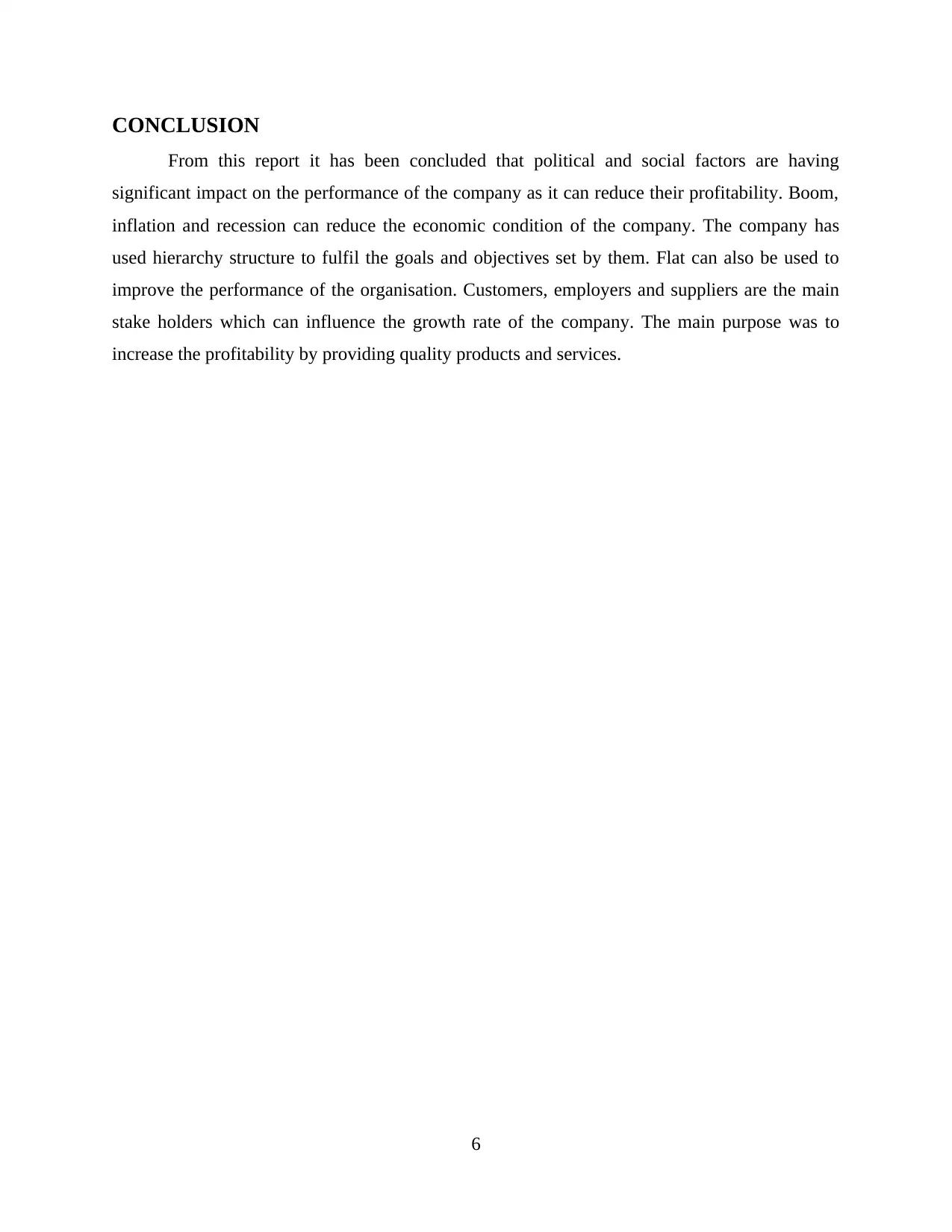
CONCLUSION
From this report it has been concluded that political and social factors are having
significant impact on the performance of the company as it can reduce their profitability. Boom,
inflation and recession can reduce the economic condition of the company. The company has
used hierarchy structure to fulfil the goals and objectives set by them. Flat can also be used to
improve the performance of the organisation. Customers, employers and suppliers are the main
stake holders which can influence the growth rate of the company. The main purpose was to
increase the profitability by providing quality products and services.
6
From this report it has been concluded that political and social factors are having
significant impact on the performance of the company as it can reduce their profitability. Boom,
inflation and recession can reduce the economic condition of the company. The company has
used hierarchy structure to fulfil the goals and objectives set by them. Flat can also be used to
improve the performance of the organisation. Customers, employers and suppliers are the main
stake holders which can influence the growth rate of the company. The main purpose was to
increase the profitability by providing quality products and services.
6
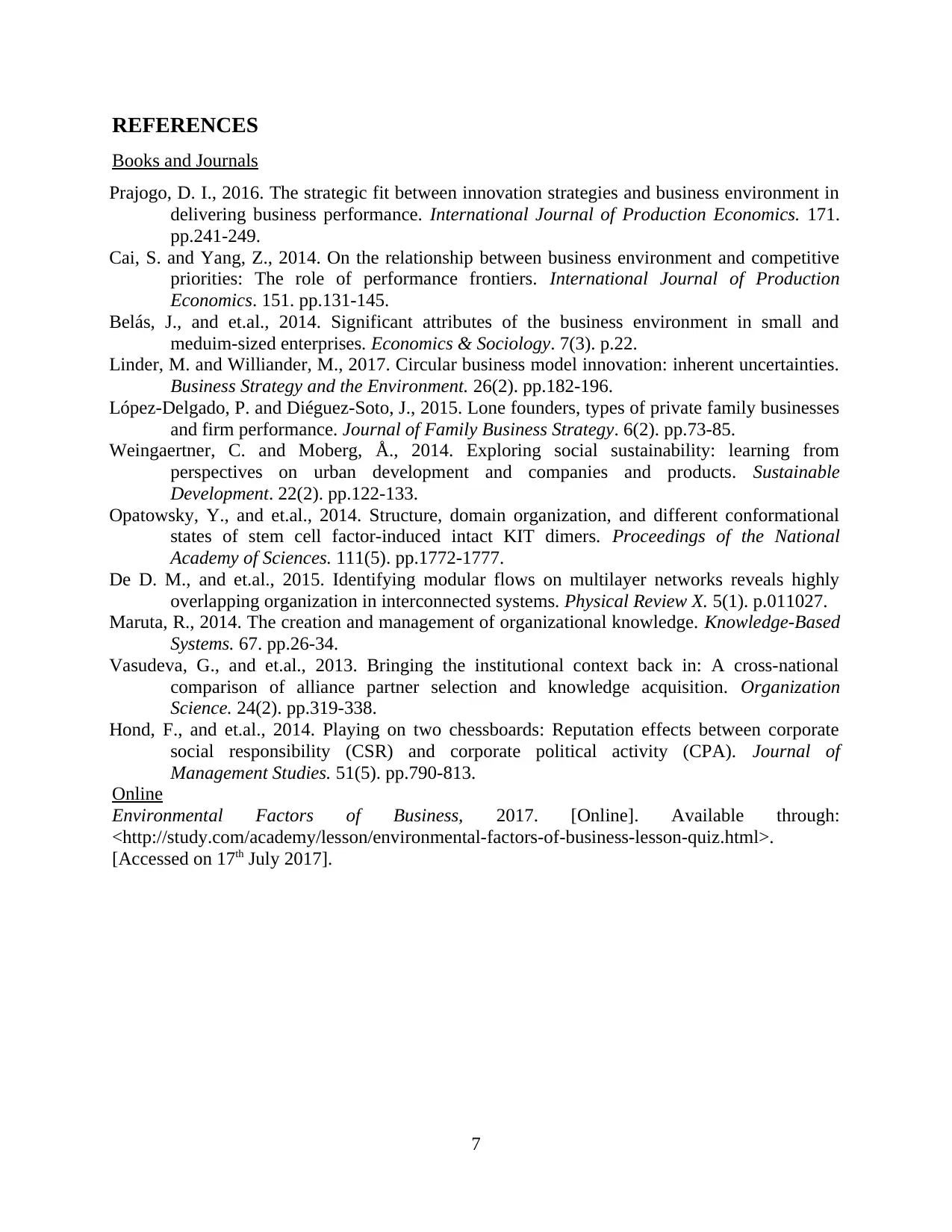
REFERENCES
Books and Journals
Prajogo, D. I., 2016. The strategic fit between innovation strategies and business environment in
delivering business performance. International Journal of Production Economics. 171.
pp.241-249.
Cai, S. and Yang, Z., 2014. On the relationship between business environment and competitive
priorities: The role of performance frontiers. International Journal of Production
Economics. 151. pp.131-145.
Belás, J., and et.al., 2014. Significant attributes of the business environment in small and
meduim-sized enterprises. Economics & Sociology. 7(3). p.22.
Linder, M. and Williander, M., 2017. Circular business model innovation: inherent uncertainties.
Business Strategy and the Environment. 26(2). pp.182-196.
López-Delgado, P. and Diéguez-Soto, J., 2015. Lone founders, types of private family businesses
and firm performance. Journal of Family Business Strategy. 6(2). pp.73-85.
Weingaertner, C. and Moberg, Å., 2014. Exploring social sustainability: learning from
perspectives on urban development and companies and products. Sustainable
Development. 22(2). pp.122-133.
Opatowsky, Y., and et.al., 2014. Structure, domain organization, and different conformational
states of stem cell factor-induced intact KIT dimers. Proceedings of the National
Academy of Sciences. 111(5). pp.1772-1777.
De D. M., and et.al., 2015. Identifying modular flows on multilayer networks reveals highly
overlapping organization in interconnected systems. Physical Review X. 5(1). p.011027.
Maruta, R., 2014. The creation and management of organizational knowledge. Knowledge-Based
Systems. 67. pp.26-34.
Vasudeva, G., and et.al., 2013. Bringing the institutional context back in: A cross-national
comparison of alliance partner selection and knowledge acquisition. Organization
Science. 24(2). pp.319-338.
Hond, F., and et.al., 2014. Playing on two chessboards: Reputation effects between corporate
social responsibility (CSR) and corporate political activity (CPA). Journal of
Management Studies. 51(5). pp.790-813.
Online
Environmental Factors of Business, 2017. [Online]. Available through:
<http://study.com/academy/lesson/environmental-factors-of-business-lesson-quiz.html>.
[Accessed on 17th July 2017].
7
Books and Journals
Prajogo, D. I., 2016. The strategic fit between innovation strategies and business environment in
delivering business performance. International Journal of Production Economics. 171.
pp.241-249.
Cai, S. and Yang, Z., 2014. On the relationship between business environment and competitive
priorities: The role of performance frontiers. International Journal of Production
Economics. 151. pp.131-145.
Belás, J., and et.al., 2014. Significant attributes of the business environment in small and
meduim-sized enterprises. Economics & Sociology. 7(3). p.22.
Linder, M. and Williander, M., 2017. Circular business model innovation: inherent uncertainties.
Business Strategy and the Environment. 26(2). pp.182-196.
López-Delgado, P. and Diéguez-Soto, J., 2015. Lone founders, types of private family businesses
and firm performance. Journal of Family Business Strategy. 6(2). pp.73-85.
Weingaertner, C. and Moberg, Å., 2014. Exploring social sustainability: learning from
perspectives on urban development and companies and products. Sustainable
Development. 22(2). pp.122-133.
Opatowsky, Y., and et.al., 2014. Structure, domain organization, and different conformational
states of stem cell factor-induced intact KIT dimers. Proceedings of the National
Academy of Sciences. 111(5). pp.1772-1777.
De D. M., and et.al., 2015. Identifying modular flows on multilayer networks reveals highly
overlapping organization in interconnected systems. Physical Review X. 5(1). p.011027.
Maruta, R., 2014. The creation and management of organizational knowledge. Knowledge-Based
Systems. 67. pp.26-34.
Vasudeva, G., and et.al., 2013. Bringing the institutional context back in: A cross-national
comparison of alliance partner selection and knowledge acquisition. Organization
Science. 24(2). pp.319-338.
Hond, F., and et.al., 2014. Playing on two chessboards: Reputation effects between corporate
social responsibility (CSR) and corporate political activity (CPA). Journal of
Management Studies. 51(5). pp.790-813.
Online
Environmental Factors of Business, 2017. [Online]. Available through:
<http://study.com/academy/lesson/environmental-factors-of-business-lesson-quiz.html>.
[Accessed on 17th July 2017].
7
⊘ This is a preview!⊘
Do you want full access?
Subscribe today to unlock all pages.

Trusted by 1+ million students worldwide
1 out of 9
Related Documents
Your All-in-One AI-Powered Toolkit for Academic Success.
+13062052269
info@desklib.com
Available 24*7 on WhatsApp / Email
![[object Object]](/_next/static/media/star-bottom.7253800d.svg)
Unlock your academic potential
Copyright © 2020–2025 A2Z Services. All Rights Reserved. Developed and managed by ZUCOL.





